Large Particle 3D Concrete Printing—A Green and Viable Solution
Abstract
1. Introduction
- material savings through new design and production techniques, e.g., by producing material-efficient structures using additive manufacturing, in which material is placed only where it is structurally needed,
- reductions in the cement content in the concrete and,
- (more) sustainable circular concrete composition, for example, by adding recycled aggregates.
2. State of the Art: Basic Principles of Additive Manufacturing in Construction
- (a).
- material extrusion,
- (b).
- material jetting,
- (c).
- particle-bed binding.
3. Large Particle 3D Concrete Printing: Basic Principle
4. Material Investigations
4.1. Hypothesis and Concept of Investigations
- Modifying the rheological properties (especially the yield stress) with the help of superplasticizers and stabilizers. On the one hand, a low yield stress is required to enable a full penetration of the aggregate layer by means of the injected material. On the other hand, the risk of the injected material running through the particle bed layer is increased, i.e., the geometric precision is reduced.
- Modifying the packing density of the large particle bed. A higher packing density may have the advantage of a better mechanical performance, since the increase in aggregate volume is commonly known to increase the compressive strength of concrete, e.g., [41]. However, the penetration depth of the applied material is reduced and may hinder a good mechanical bonding between the layers, which finally affects the mechanical performance in a negative way.
4.2. Materials
4.2.1. Particle Bed
4.2.2. Fine Grained Sprayed Concrete
4.3. Methods
4.3.1. Rheology of the Fine Grained Sprayed Concrete
4.3.2. Large Particle 3D Concrete Printing for Material Investigations
4.3.3. Compressive Strength, Geometric Precision and Inner Structure
4.4. Results
4.4.1. Rheological Properties of the Fine Grained Sprayed Concrete
4.4.2. Geometry of the Produced Strands
4.4.3. Structural Bonding Characteristics
4.4.4. Compressive Strength
4.5. Life Cycle Assessment of Large Particle 3D Concrete Printing
5. Large-Scale Demonstrator
5.1. Experimental Setup
5.1.1. Robotic Setup
5.1.2. Additional Materials: Glass Fiber Reinforcement
5.2. Design-to-Fabrication Workflow
5.2.1. Form Finding
5.2.2. Robotic Path Planning
5.3. Fabrication Process
5.3.1. Additive Manufacturing
5.3.2. Demoulding and Edge Milling
5.4. Results
6. Summary
7. Outlook
Author Contributions
Funding
Institutional Review Board Statement
Informed Consent Statement
Data Availability Statement
Acknowledgments
Conflicts of Interest
References
- Schneider, M. The cement industry on the way to a low-carbon future. Cem. Concr. Res. 2019, 124, 105792. [Google Scholar] [CrossRef]
- Haist, M.; Moffatt, J.S.; Breiner, R.; Müller, H.S. Development principles and technical boundaries of concrete production with low cement content. Beton Stahlbetonbau 2014, 109, 202–215. [Google Scholar] [CrossRef]
- Scrivener, K.L.; John, V.M.; Gartner, E.M. Eco-efficient cements: Potential economically viable solutions for a low-CO2 cement-based materials industry. Cem. Concr. Res. 2018, 114, 2–26. [Google Scholar] [CrossRef]
- FIB. Guidelines for Green Concrete Structures; FIB Bulletin No. 67; FIB: Lausanne, Switzerland, 2012; ISBN 9782883941076. [Google Scholar]
- Menna, C.; Mata-Falcón, J.; Bos, F.P.; Vantyghem, G.; Ferrara, L.; Asprone, D.; Salet, T.; Kaufmann, W. Opportunities and challenges for structural engineering of digitally fabricated concrete. Cem. Concr. Res. 2020, 133, 106079. [Google Scholar] [CrossRef]
- Kloft, H.; Gehlen, C.; Dörfler, K.; Hack, N.; Henke, K.; Lowke, D.; Mainka, J.; Raatz, A. TRR 277: Additive manufacturing in Construction. Bautechnik 2021, 98, 222–231. (In German) [Google Scholar] [CrossRef]
- Agusti-Juan, I.; Habert, G. Environmental design guidelines for digital fabrication. J. Clean. Prod. 2017, 142, 2780–2791. [Google Scholar] [CrossRef]
- Agusti-Juan, I.; Müller, F.; Hack, N.; Wangler, T.; Habert, G. Potential benefits of digital fabrication for complex structures: Environmental assessment of a robotically fabricated concrete wall. J. Clean. Prod. 2017, 154, 330–340. [Google Scholar] [CrossRef]
- Suhendro, B. Toward green concrete for better sustainable environment. Procedia Eng. 2014, 95, 305–320. [Google Scholar] [CrossRef]
- Lowke, D.; Dini, E.; Perrot, A.; Weger, D.; Gehlen, C.; Dillenburger, B. Particle-bed 3D printing in concrete construction—Possibilities and challenges. Cem. Concr. Res. 2018, 112, 50–65. [Google Scholar] [CrossRef]
- Khan, M.S.; Sanchez, F.; Zhou, H. 3-D printing of concrete: Beyond horizons. Cem. Concr. Res. 2020, 133, 106070. [Google Scholar] [CrossRef]
- Vasilic, K. Additive Manufacturing with Concrete; CPT: Cologne, Germany, 2020; pp. 19–26. [Google Scholar]
- Roussel, N. Rheological requirements for printable concretes. Cem. Concr. Res. 2018, 112, 76–85. [Google Scholar] [CrossRef]
- Wangler, T.; Lloret, E.; Reiter, L.; Hack, N.; Gramazio, F.; Kohler, M.; Bernhard, M.; Dillenburger, B.; Buchli, J.; Roussel, N.; et al. Digital concrete: Opportunities and challenges. RILEM Technol. Lett. 2016, 1, 67–75. [Google Scholar] [CrossRef]
- Wangler, T.; Roussel, N.; Bos, F.P.; Salet, T.A.M.; Flatt, R.J. Digital concrete: A review. Cem. Concr. Res. 2019, 123, 105780. [Google Scholar] [CrossRef]
- Kloft, H.; Hack, N.; Mainka, J.; Lowke, D. Large scale 3D concrete printing. Constr. Print. Technol. 2019, 1, 17–24. [Google Scholar]
- Kloft, H.; Krauss, H.-W.; Hack, N.; Herrmann, E.; Neudecker, S.; Varady, P.; Lowke, D. Shotcrete 3D Printing (SC3DP): A robot-guided technology for additive manufacturing of large-scale reinforced concrete components. Cem. Concr. Res. 2020, 134, 106078. [Google Scholar] [CrossRef]
- Lowke, D.; Talke, D.; Dressler, I.; Weger, D.; Gehlen, C.; Ostertag, C.; Rael, R. Particle-bed 3D-printing by selective cement activation—Applications, material and process technology. Cem. Concr. Res. 2020, 134, 106077. [Google Scholar] [CrossRef]
- Lowke, D.; Vandenberg, A.; Pierre, A.; Thomas, A.; Kloft, H.; Hack, N. Injection 3D Concrete Printing in a carrier liquid—Underlying physics and applications to lightweight space frame structures. Cem. Concr. Compos. 2021, 124, 104169. [Google Scholar] [CrossRef]
- Dressler, I.; Freund, N.; Lowke, D. Control of strand properties produced with shotcrete 3d printing by accelerator dosage and process parameters. In Second RILEM International Conference on Concrete and Digital Fabrication: Digital Concrete 2020; Bos, F., Lucas, S., Wolfs, R., Salet, T., Eds.; Springer: Berlin/Heidelberg, Germany, 2020; pp. 42–52. [Google Scholar]
- Buswell, R.A.; Da Silva, W.L.; Bos, F.P.; Schipper, H.R.; Lowke, D.; Hack, N.; Kloft, H.; Mechtcherine, V.; Wangler, T.; Roussel, N. A process classification framework for defining and describing Digital Fabrication with Concrete. Cem. Concr. Res. 2020, 134, 106068. [Google Scholar] [CrossRef]
- Hack, N.; Dressler, I.; Brohmann, L.; Gantner, S.; Lowke, D.; Kloft, H. Injection 3D concrete printing (I3DCP): Basic principles and case studies. Materials 2020, 13, 1093. [Google Scholar] [CrossRef] [PubMed]
- Mechtcherine, V.; Bos, F.P.; Perrot, A.; Da Silva, W.L.; Nerella, V.N.; Fataei, S.; Wolfs, R.J.M.; Sonebi, M.; Roussel, N. Extrusion-based additive manufacturing with cement-based materials—Production steps, processes, and their underlying physics: A review. Cem. Concr. Res. 2020, 132, 106037. [Google Scholar] [CrossRef]
- Wolfs, R.J.M.; Bos, F.P.; Salet, T.A.M. Early age mechanical behaviour of 3D printed concrete: Numerical modelling and experimental testing. Cem. Concr. Res. 2018, 106, 103–116. [Google Scholar] [CrossRef]
- Dressler, I.; Freund, N.; Lowke, D. The effect of accelerator dosage on fresh concrete properties and on interlayer strength in shotcrete 3D printing. Materials 2020, 13, 374. [Google Scholar] [CrossRef] [PubMed]
- Buswell, R.A.; Leal de Silva, W.R.; Jones, S.Z.; Dirrenberger, J. 3D printing using concrete extrusion: A roadmap for research. Cem. Concr. Res. 2018, 112, 37–49. [Google Scholar] [CrossRef]
- Asprone, D.; Auricchio, F.; Menna, C.; Mercuri, V. 3D printing of reinforced concrete elements: Technology and design approach. Constr. Build. Mater. 2018, 165, 218–231. [Google Scholar] [CrossRef]
- Asprone, D.; Menna, C.; Bos, F.P.; Salet, T.A.M.; Mata-Falcón, J.; Kaufmann, W. Rethinking reinforcement for digital fabrication with concrete. Cem. Concr. Res. 2018, 112, 111–121. [Google Scholar] [CrossRef]
- Khoshnevis, B. Automated construction by contour crafting—Related robotics and information technologies. Autom. Constr. 2004, 13, 5–19. [Google Scholar] [CrossRef]
- Khoshnevis, B.; Dutton, R. Innovative rapid prototyping process makes large sized, smooth surfaced complex shapes in a wide variety of materials. Mater. Technol. 1998, 13, 53–56. [Google Scholar] [CrossRef]
- Khoshnevis, B.; Hwang, D.; Yao, K.T.; Yeh, Z. Mega-scale fabrication by contour crafting. Int. J. Ind. Syst. Eng. 2006, 1, 301. [Google Scholar] [CrossRef]
- Khoshnevis, B.; Bukkapatnam, S.; Kwon, H.; Saito, J. Experimental investigation of contour crafting using ceramics materials. Rapid Prototyp. J. 2001, 7, 32–42. [Google Scholar] [CrossRef]
- Sanjayan, J.G.; Nazari, A.; Nematollahi, B. 3D Concrete Printing Technology; Sanjayan, J., Nazari, A., Nematollahi, B., Eds.; Butterworth-Heinemann: Oxford, UK, 2019. [Google Scholar]
- Nerella, V.; Mechtcherine, V. Chapter 16—Studying the printability of fresh concrete for formwork-free concrete onsite 3D printing technology (CONPrint3D). In 3D Concrete Printing Technology; Sanjayan, J., Nazari, A., Nematollahi, B., Eds.; Butterworth-Heinemann: Oxford, UK, 2019; pp. 333–347. [Google Scholar]
- Pierre, A.; Weger, D.; Perrot, A.; Lowke, D. Penetration of cement pastes into sand packings during 3D printing: Analytical and experimental study. Mater. Struct. 2018, 51, 22. [Google Scholar] [CrossRef]
- Xia, M.; Nematollahi, B.; Sanjayan, J. Influence of binder saturation level on compressive strength and dimensional accuracy of powder-based 3D printed geopolymer. Mat. Sci. Forum 2018, 939, 177–183. [Google Scholar] [CrossRef]
- Weger, D.; Gehlen, C.; Lowke, D. Additive Fertigung von Betonbauteilen durch selektive Zementleim-Intrusion. In Proceedings of the Ibausil 2018, Weimar, Germany, 12–14 September 2018. [Google Scholar]
- Yu, S.; Hu, H.; Sanjayan, J.G. Aggregate-bed 3D concrete printing with cement paste binder. Cem. Concr. Res. 2020, 136, 106169. [Google Scholar] [CrossRef]
- Weger, D.; Pierre, A.; Perrot, A.; Kränkel, T.; Lowke, D.; Gehlen, C. Penetration of cement pastes into particle-beds: A comparison of penetration models. Materials 2021, 14, 389. [Google Scholar] [CrossRef]
- Rippmann, M.; Liew, A.; Van Mele, T.; Block, P. Design, fabrication and testing of discrete 3D sand-printed floor prototypes. Mater. Today Commun. 2018, 15, 254–259. [Google Scholar] [CrossRef]
- Stock, A.F.; Hannantt, D.J.; Williams, R.I.T. The effect of aggregate concentration upon the strength and modulus of elasticity of concrete. Mag. Concr. Res. 1979, 31, 225–234. [Google Scholar] [CrossRef]
- Schwanda, F. Der Hohlraumgehalt von Korngemischen: Ein Vergleich rechnerisch gewonnener Werte mit versuchsmäßig ermittelten. Beton 1959, 9, 427–431. [Google Scholar]
- Oger, L.; Troadec, J.P.; Bideau, D.; Dodds, J.A.; Powell, M.J. Properties of disordered sphere packings I. Geometric structure: Statistical model, numerical simulations and experimental results. Powder Technol. 1986, 46, 121–131. [Google Scholar] [CrossRef]
- De Larrard, F. Concrete Mixture Proportioning: A Scientific Approach; E&FN Spon: London, UK, 1999. [Google Scholar]
- Estellé, P.; Lanos, C.; Perrot, A.; Amziane, S. Processing the vane shear flow data from Couette analogy. Appl. Rheol. 2008, 18, 34037. [Google Scholar] [CrossRef][Green Version]
- Koehler, E.P.; Fowler, D.W. Development of a Portable Rheometer for Fresh Portland Cement Concrete; Research Report ICAR-105-3F; University of Texas: Austin, TX, USA, 2004. [Google Scholar]
- Gelardi, G.; Mantellato, S.; Marchon, D.; Palacios, M.; Eberhardt, A.B.; Flatt, R.J. Chemistry of chemical admixtures. In Science and Technology of Concrete Admixture; Woodhead Publishing: Cambridge, UK, 2016; pp. 149–218. [Google Scholar]
- Khayat, K.H.; Mikanovic, N. Viscosity-enhancing admixtures and the rheology of concrete. In Understanding the Rheology of Concrete; Roussel, N., Ed.; Woodhead Publishing Materials: Cambridge, UK, 2012; pp. 209–228. [Google Scholar]
- Khayat, K.H. Viscosity-enhancing admixtures for cement-based materials—An overview. Cem. Concr. Compos. 1998, 20, 171–188. [Google Scholar] [CrossRef]
- Mechaymech, A.; Assaad, J.J. Stability of self-consolidating concrete containing different viscosity modifiers. Civ. Eng. Infrastruct. J. 2019, 52, 245–263. [Google Scholar]
- Palacios, M.; Flatt, R.J. Working mechanism of viscosity-modifying admixtures. In Science and Technology of Concrete Admixtures; Woodhead Publishing: Cambridge, UK, 2016; pp. 415–432. [Google Scholar]
- Plank, J. Technology trends in the chemistry of PCEs and other chemical admixtures. In Proceedings of the ICSP, Beijing, China, 12–16 August 2018. [Google Scholar]
- Federal Ministry of the Interior, Building and Community. Ökobaudat–Sustainable Construction Information Portal. Available online: https://www.oekobaudat.de/en.html (accessed on 25 September 2020).
- Institut Bauen und Umwelt, e.V. EPD-Online tool of Institut Bauen und Umwelt! Information for Ecological Building Assessment–Reliable and High Quality. Available online: https://epd-online.com/ (accessed on 25 September 2020).
- Marinković, S.B.; Malešev, M.; Ignjatović, I. Life cycle assessment (LCA) of concrete made using recycled concrete or natural aggregates. In Eco-Efficient Construction and Building Materials; Woodhead Publishing: Cambridge, UK, 2014; pp. 239–266. [Google Scholar] [CrossRef]
- Kloft, H.; Hack, N.; Mainka, J.; Brohmann, L.; Herrmann, E.; Ledderose, L.; Lowke, D. Additive manufacturing in construction: First 3D-printed reinforced concrete components using Shotcrete 3D Printing (SC3DP) technology. Bautechnik 2019, 96, 929–938. (In German) [Google Scholar] [CrossRef]
- Hack, N.; Kloft, H. Shotcrete 3D Printing Technology for the Fabrication of Slender Fully Reinforced Freeform Concrete Elements with High Surface Quality: A Real-Scale Demonstrator. In Proceedings of the Second RILEM International Conference on Concrete and Digital Fabrication: Digital Concrete 2020, Eindhoven, The Netherlands, 6–7 September 2020; pp. 1128–1137. [Google Scholar]
- Empelmann, M.; Kloft, H. Practical solutions in additive manufacturing—Innovative jointing principles. BFT Int. 2021, 2, 93. [Google Scholar]
- Hack, N.; Bahar, M.; Hühne, C.; Lopez, W.; Gantner, S.; Khader, N.; Rothe, T. Development of a robot-based multi-directional dynamic fiber winding process for additive manufacturing using shotcrete 3D printing. Fibers 2021, 9, 39. [Google Scholar] [CrossRef]
- Kloft, H.; Empelmann, M.; Hack, N.; Herrmann, E.; Lowke, D. Reinforcement strategies for 3D-concrete-printing. Civ. Eng. Des. 2020, 2, 131–139. [Google Scholar] [CrossRef]
- Weger, D.; Gehlen, C. Particle-bed binding by selective paste intrusion-strength and durability of printed fine-grain concrete members. Materials 2021, 14, 586. [Google Scholar] [CrossRef] [PubMed]
- Weger, D.; Lowke, D.; Gehlen, C. 3D printing of concrete structures with calcium silicate based cements using the selective binding method—Effects of concrete tecnology on penetration depth of cement paste. In Proceedings of the 4th International Symposium on Ultra-High Performance Concrete and High Performance Construction Materials, Kassel, Germany, 9–11 March 2016; p. 10. [Google Scholar]
- Séquin, C. Turning hild’s sculptures into single-sided surfaces. Mathematics 2019, 7, 125. [Google Scholar] [CrossRef]
- Weger, D.; Baier, D.; Straßer, A.; Prottung, S.; Kränkel, T.; Bachmann, A.; Gehlen, C.; Zäh, M. Reinforced Particle-Bed Printing by Combination of the Selective Paste Intrusion Method with Wire and are Additive Manufacturing—A First Feasibility Study. In Proceedings of the Second RILEM International Conference on Concrete and Digital Fabrication: Digital Concrete 2020, Eindhoven, The Netherlands, 6–7 September 2020; pp. 978–987. [Google Scholar]
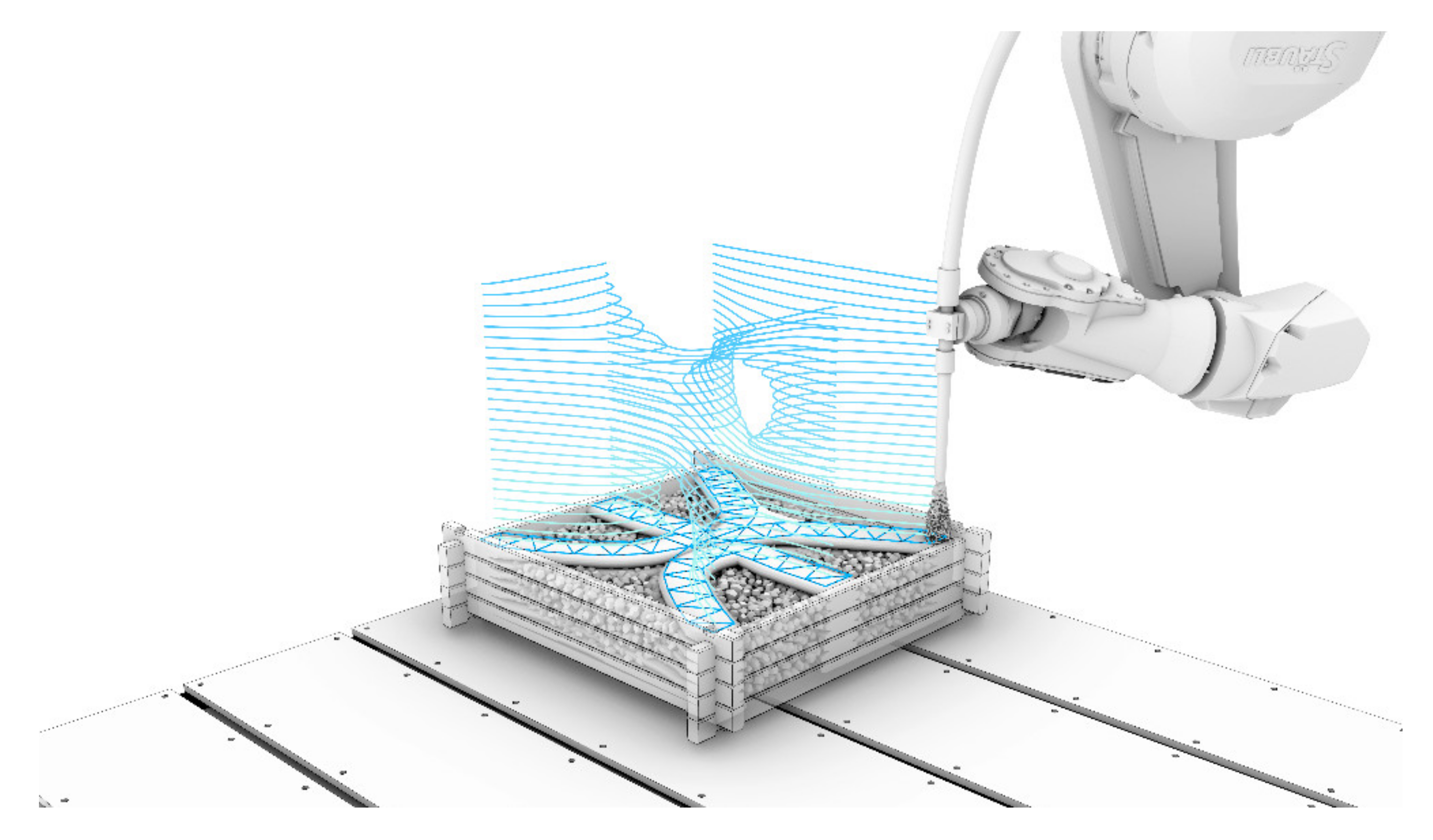
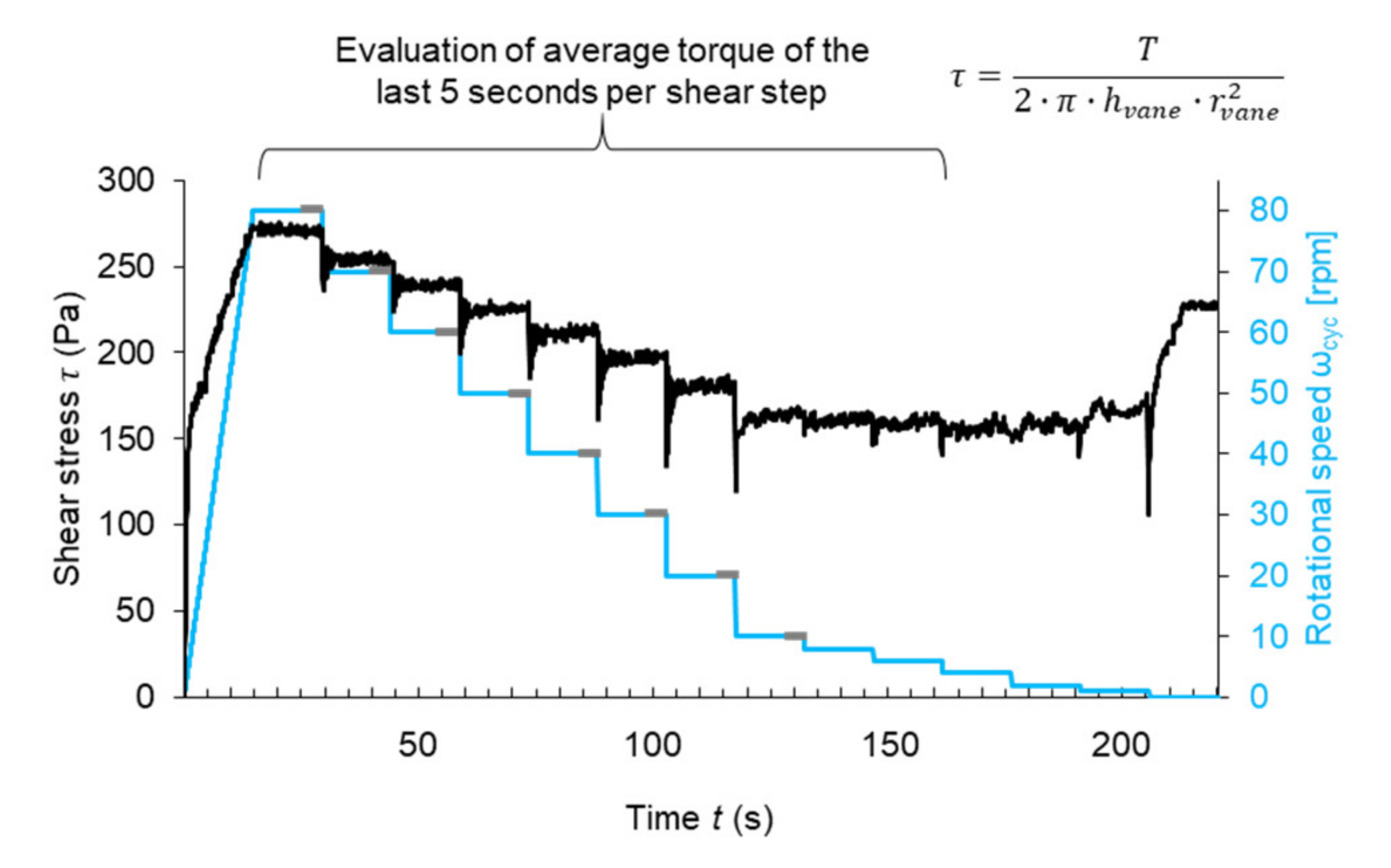
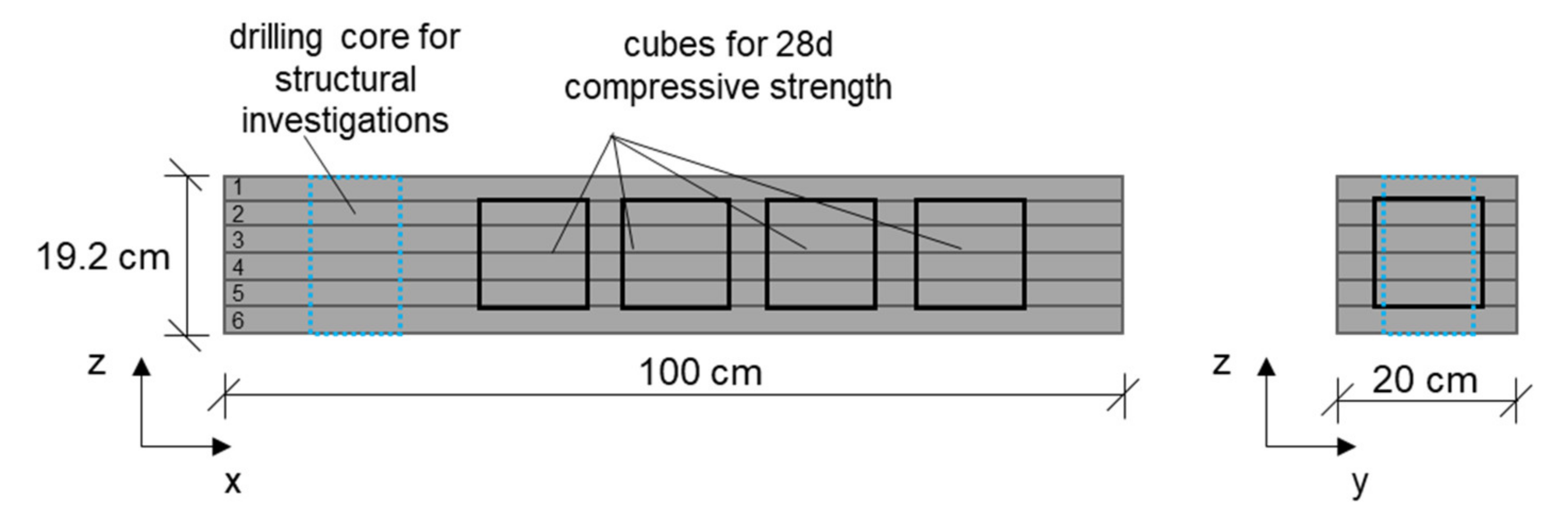
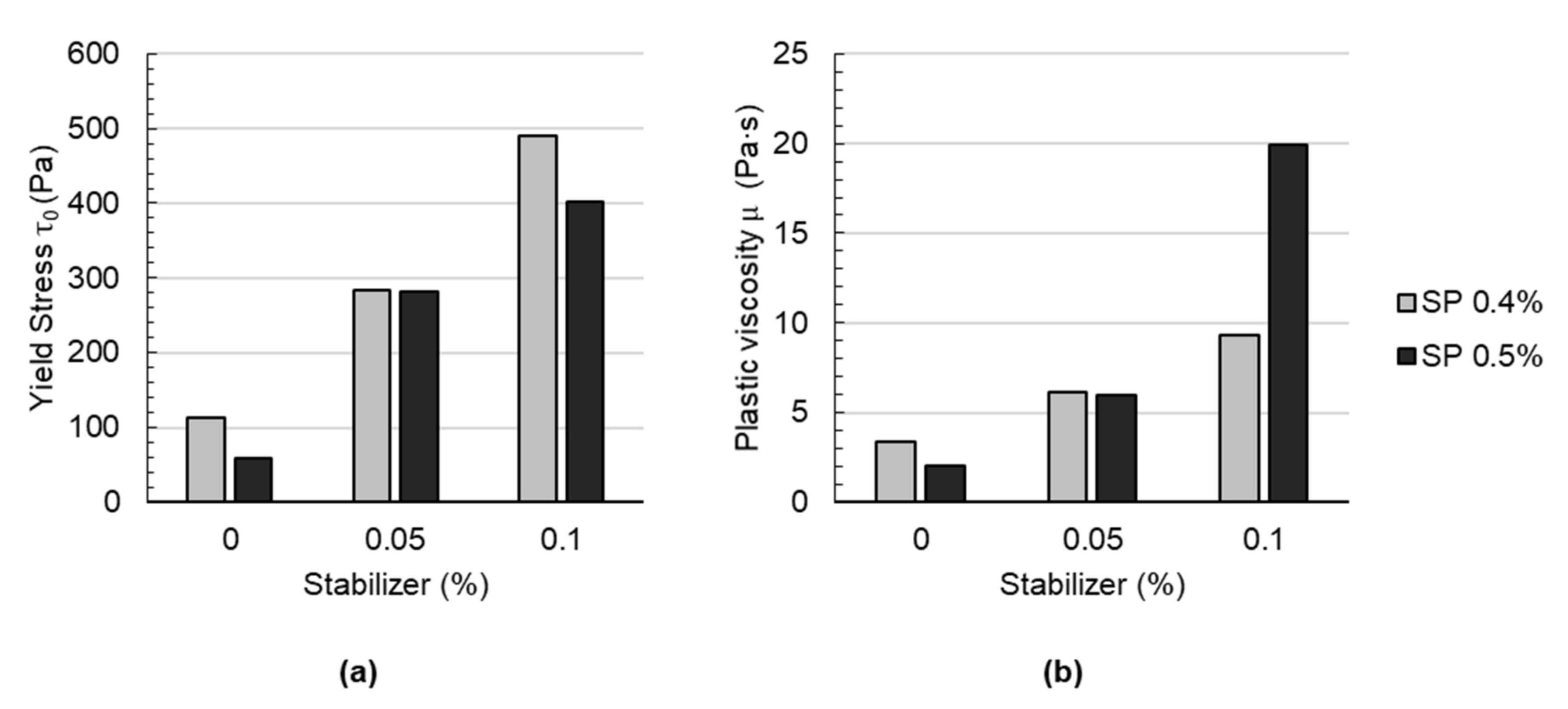
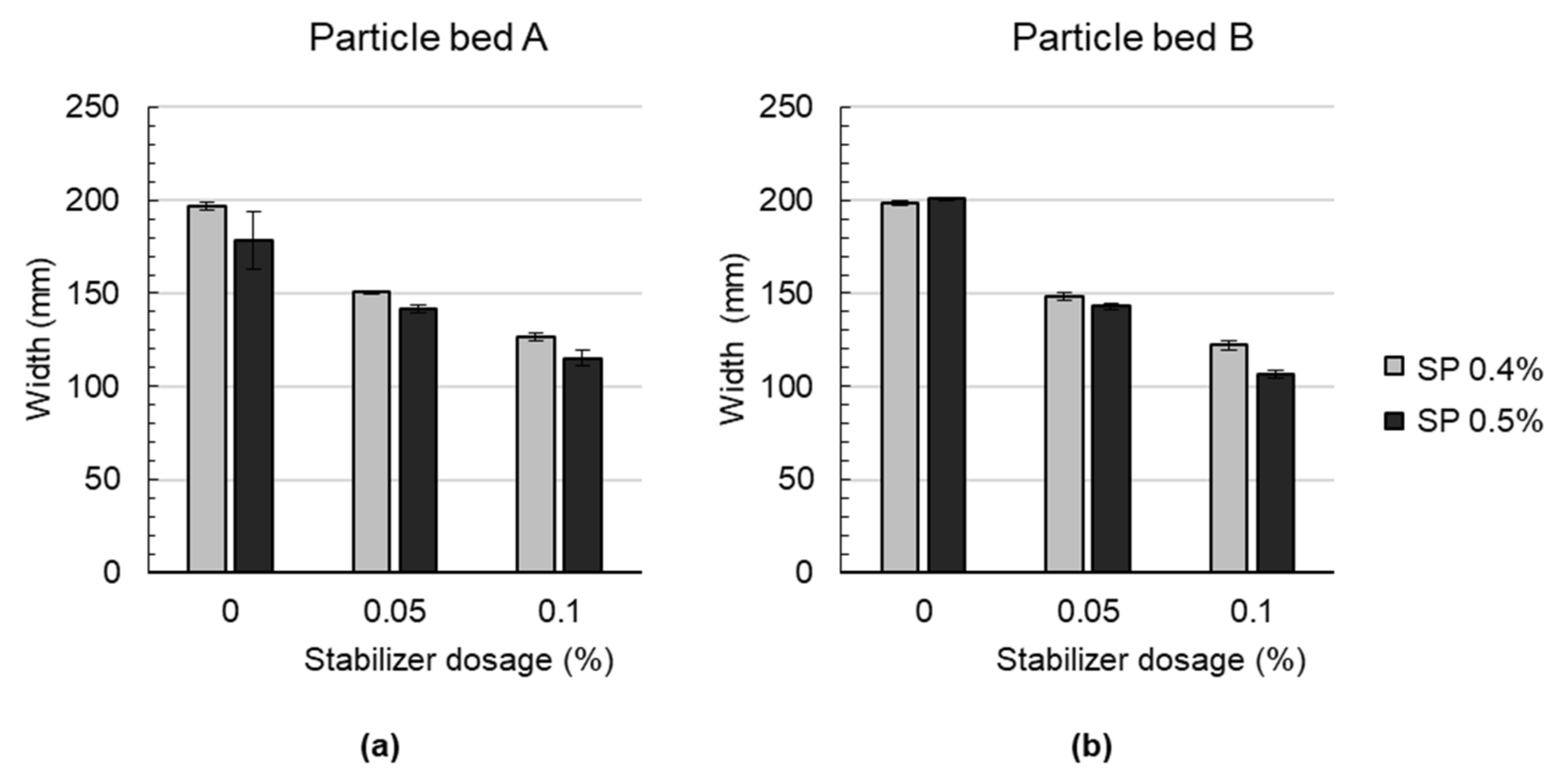
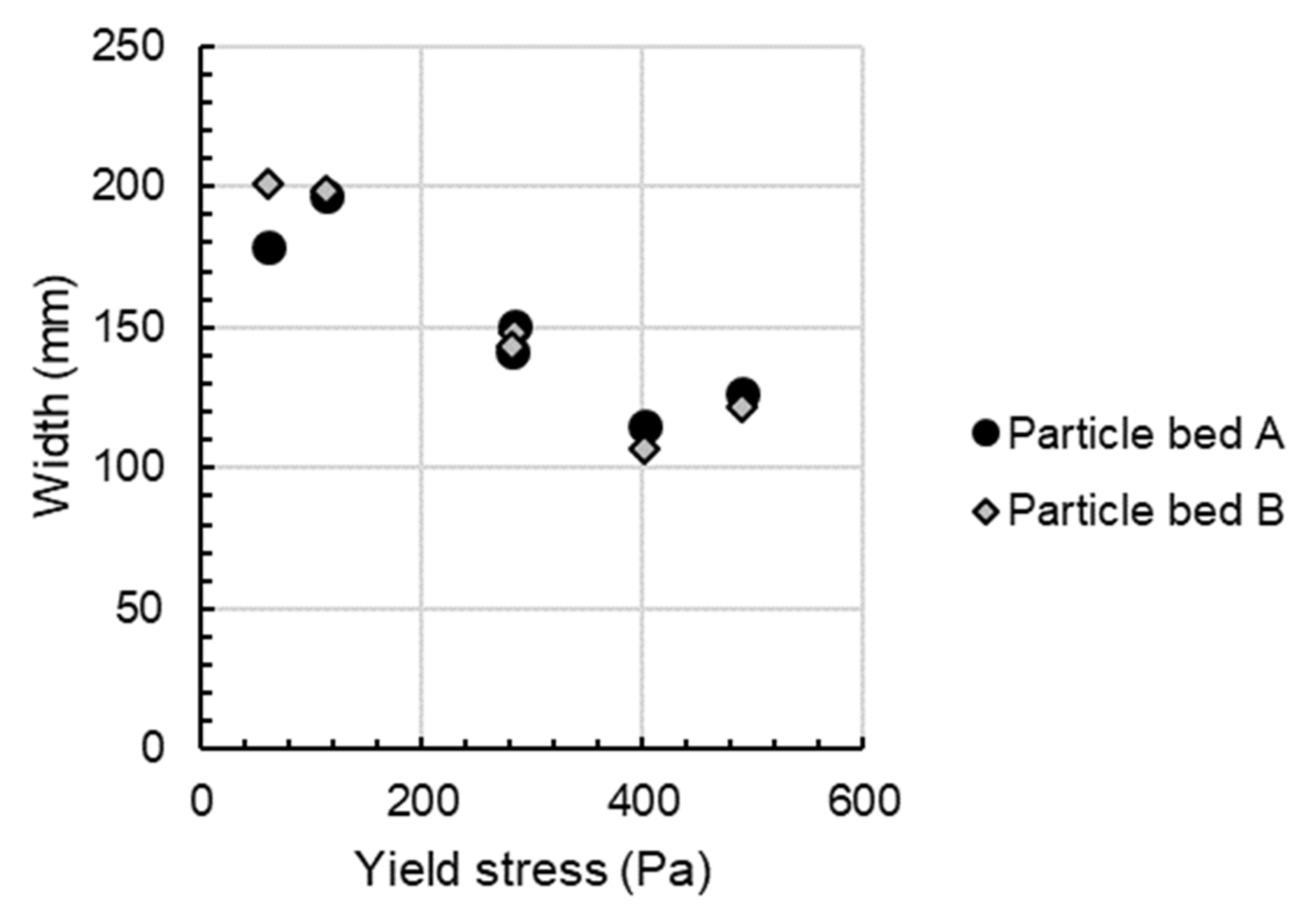
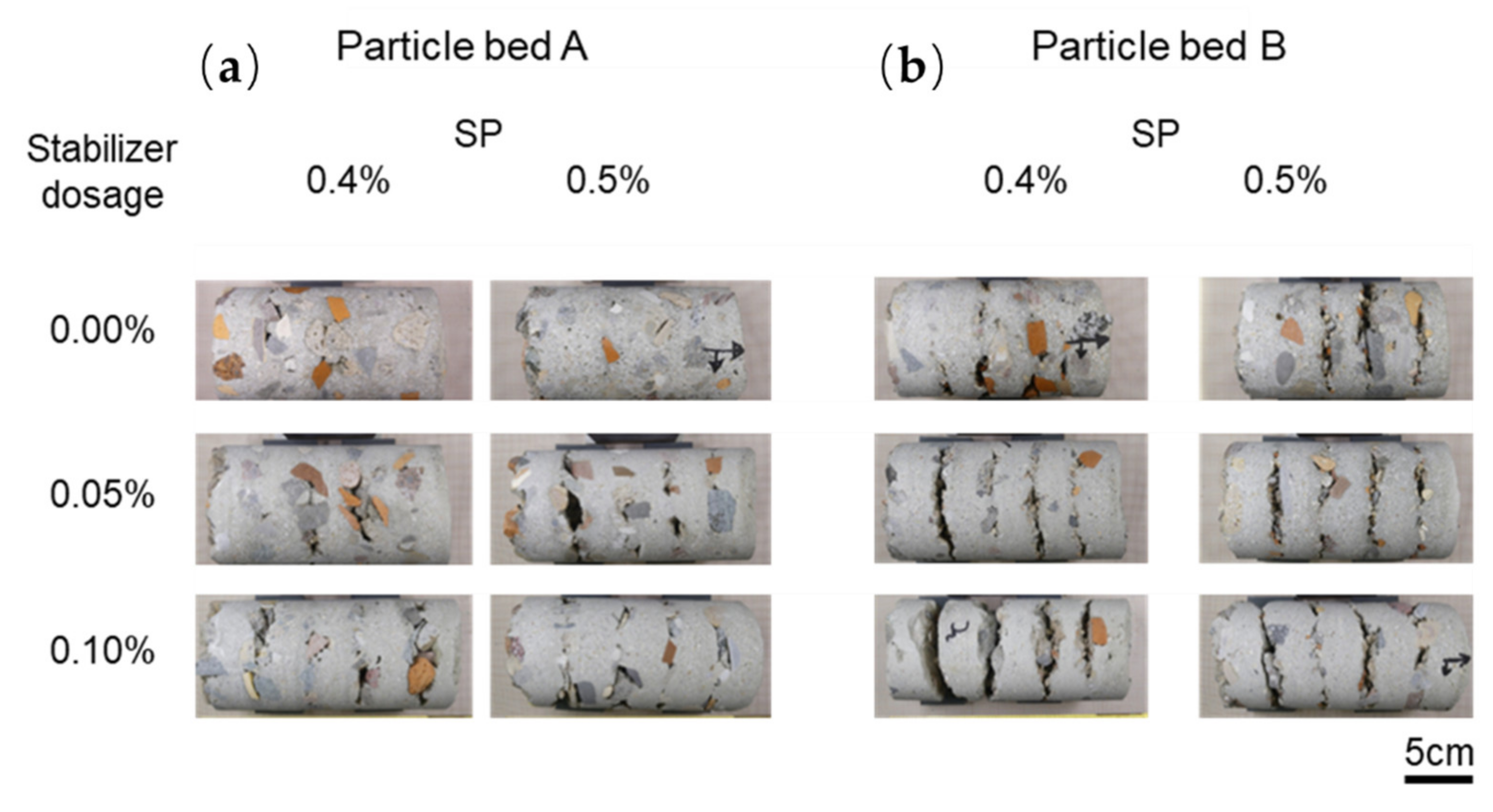
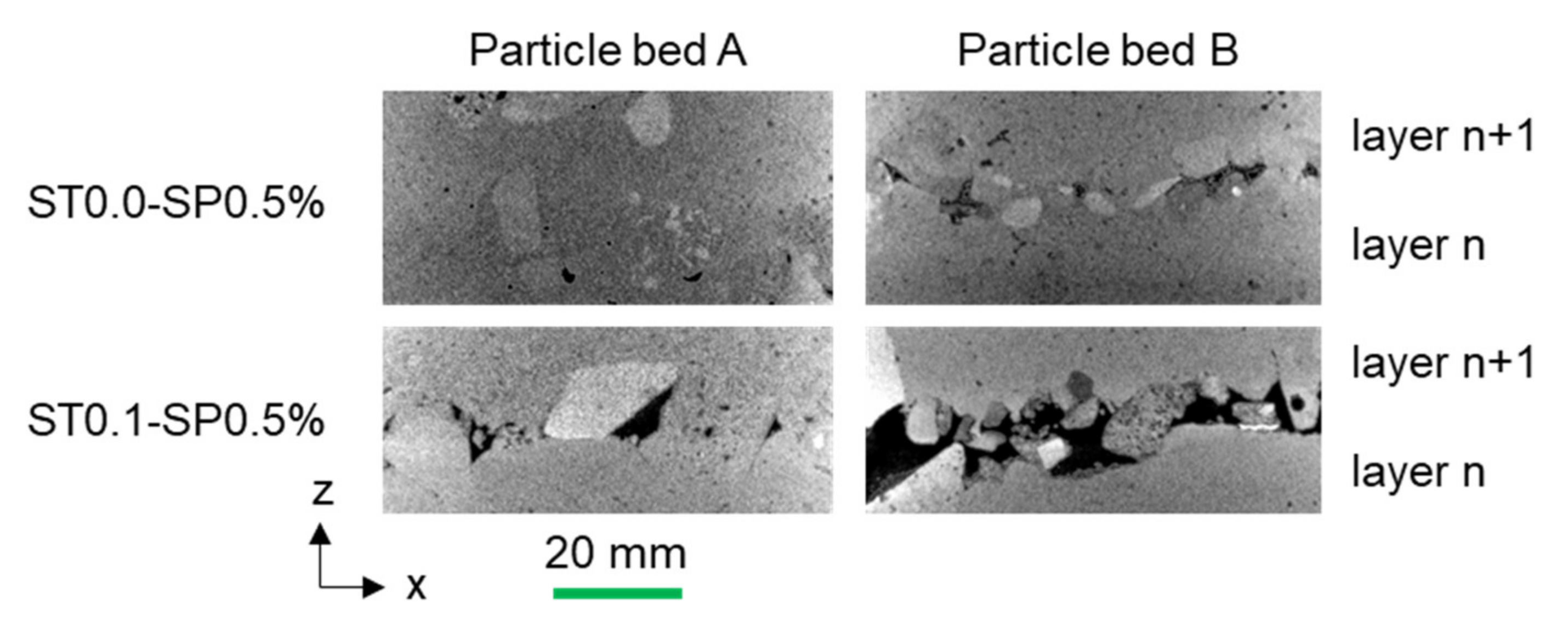
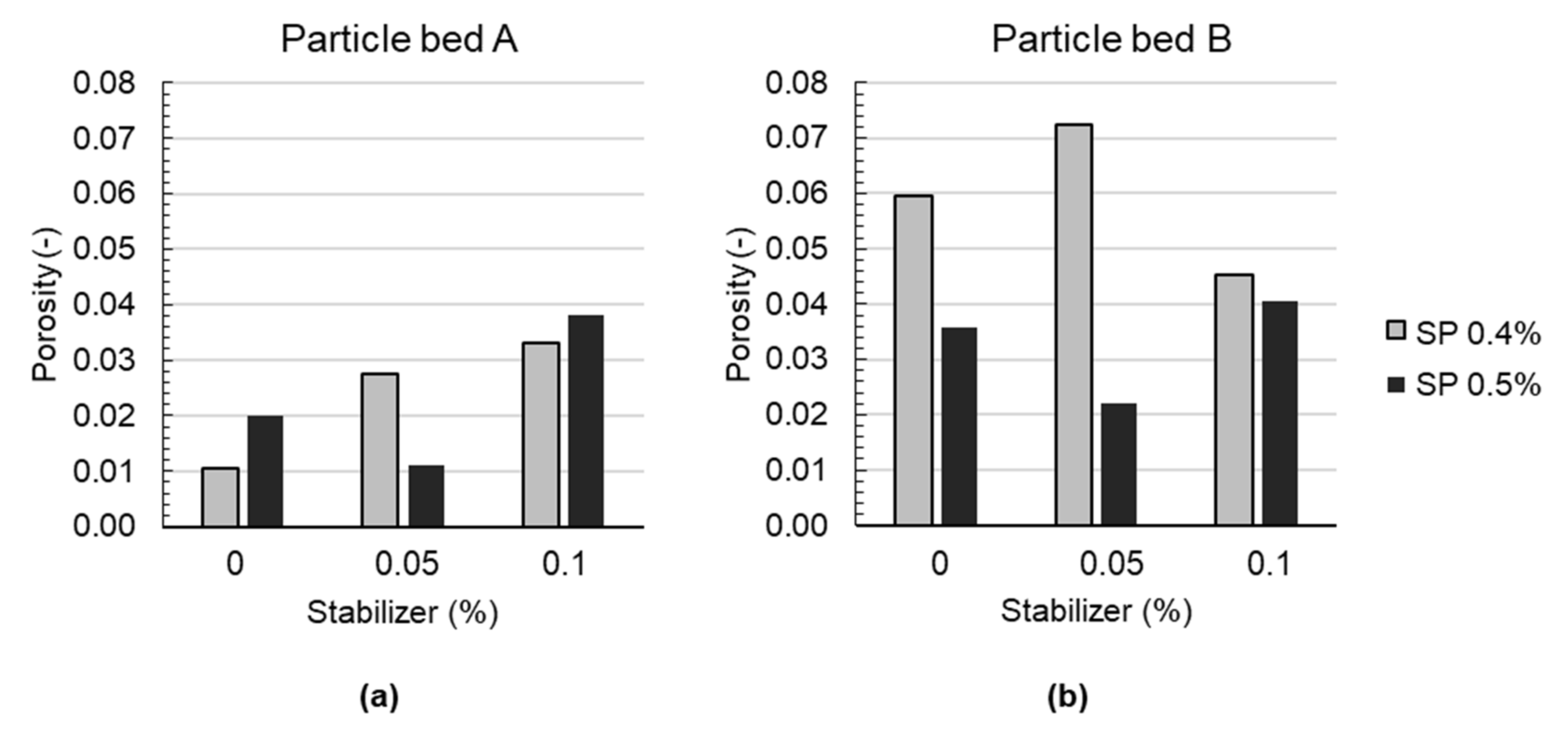
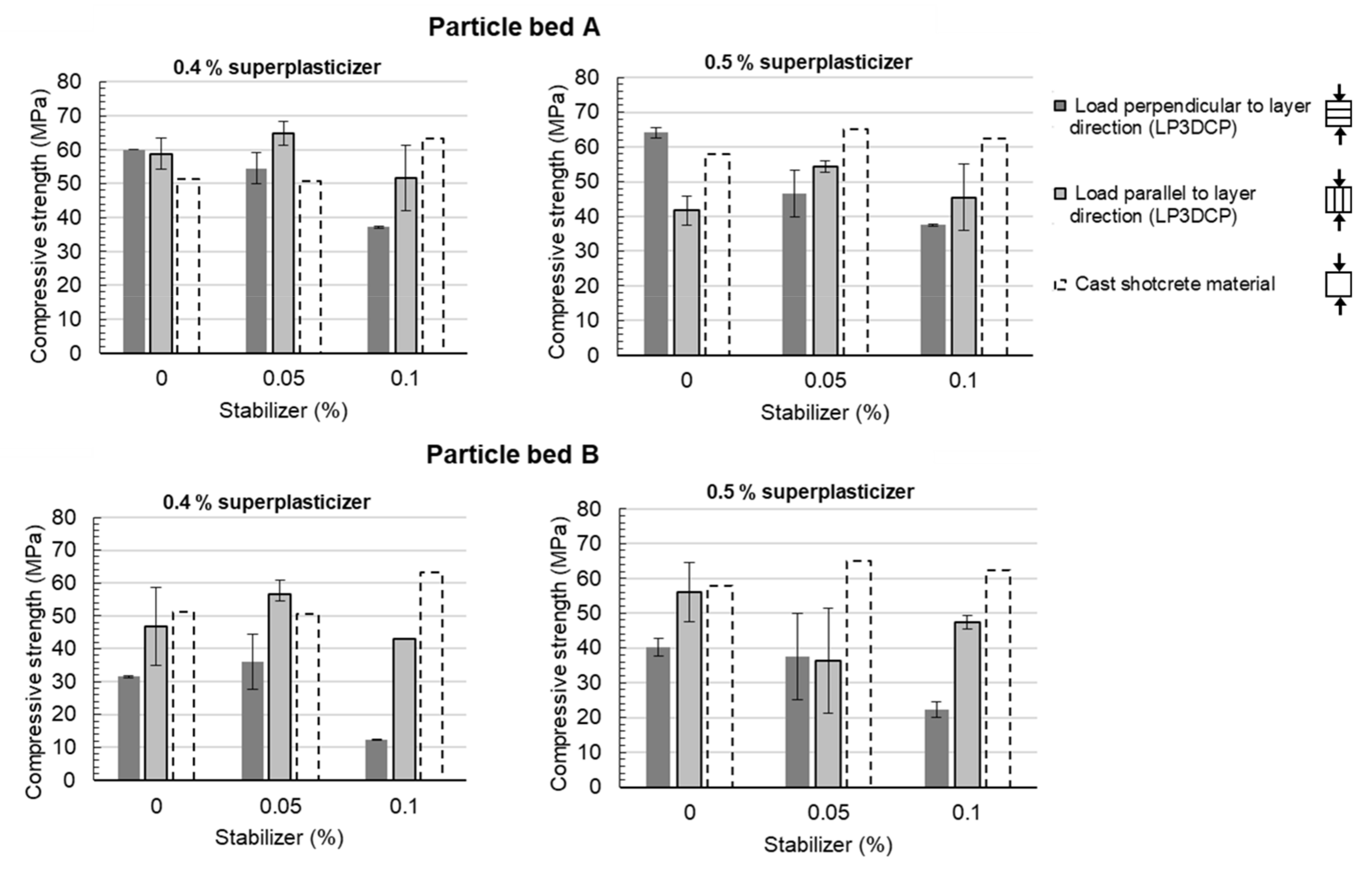
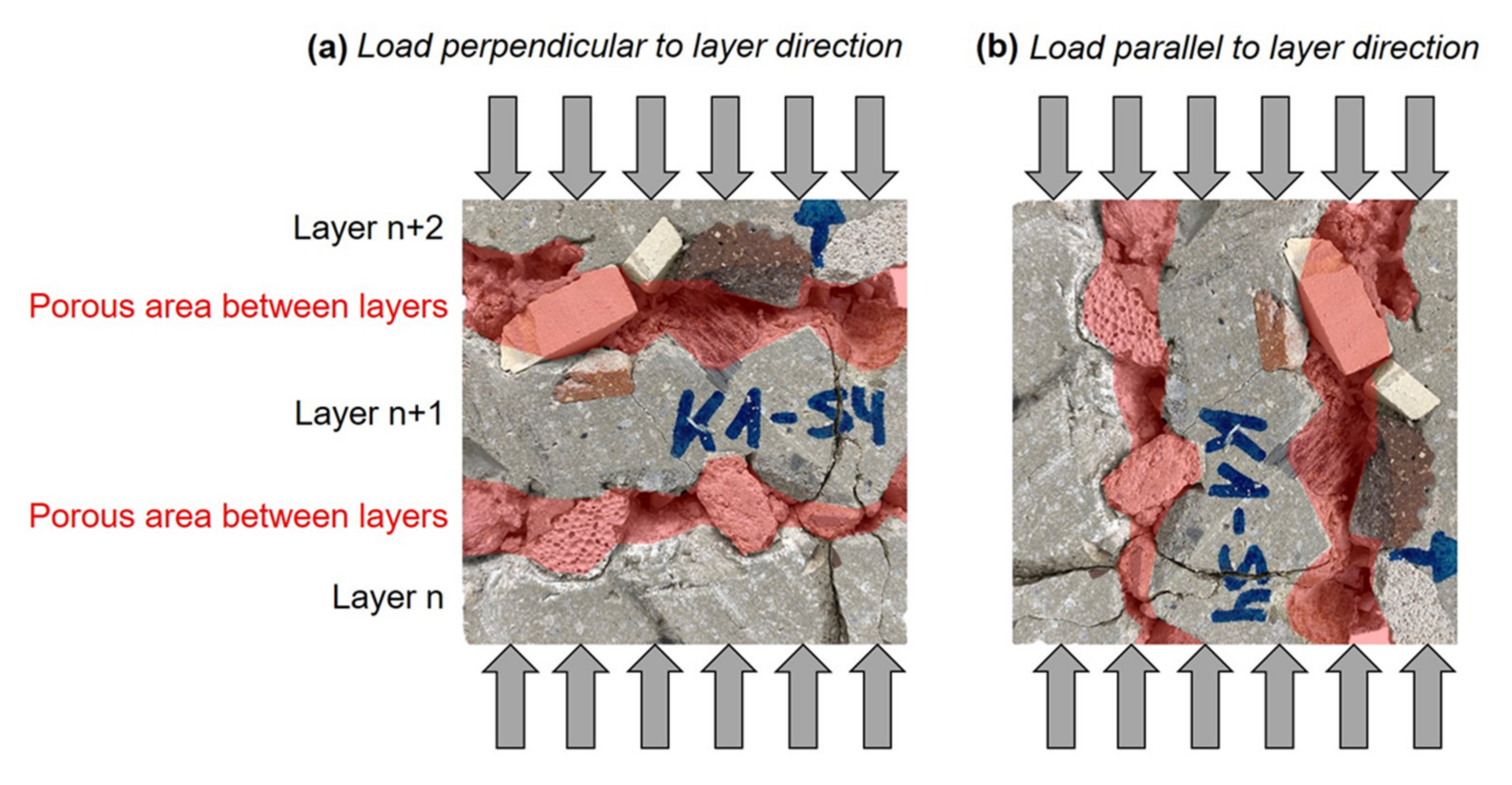
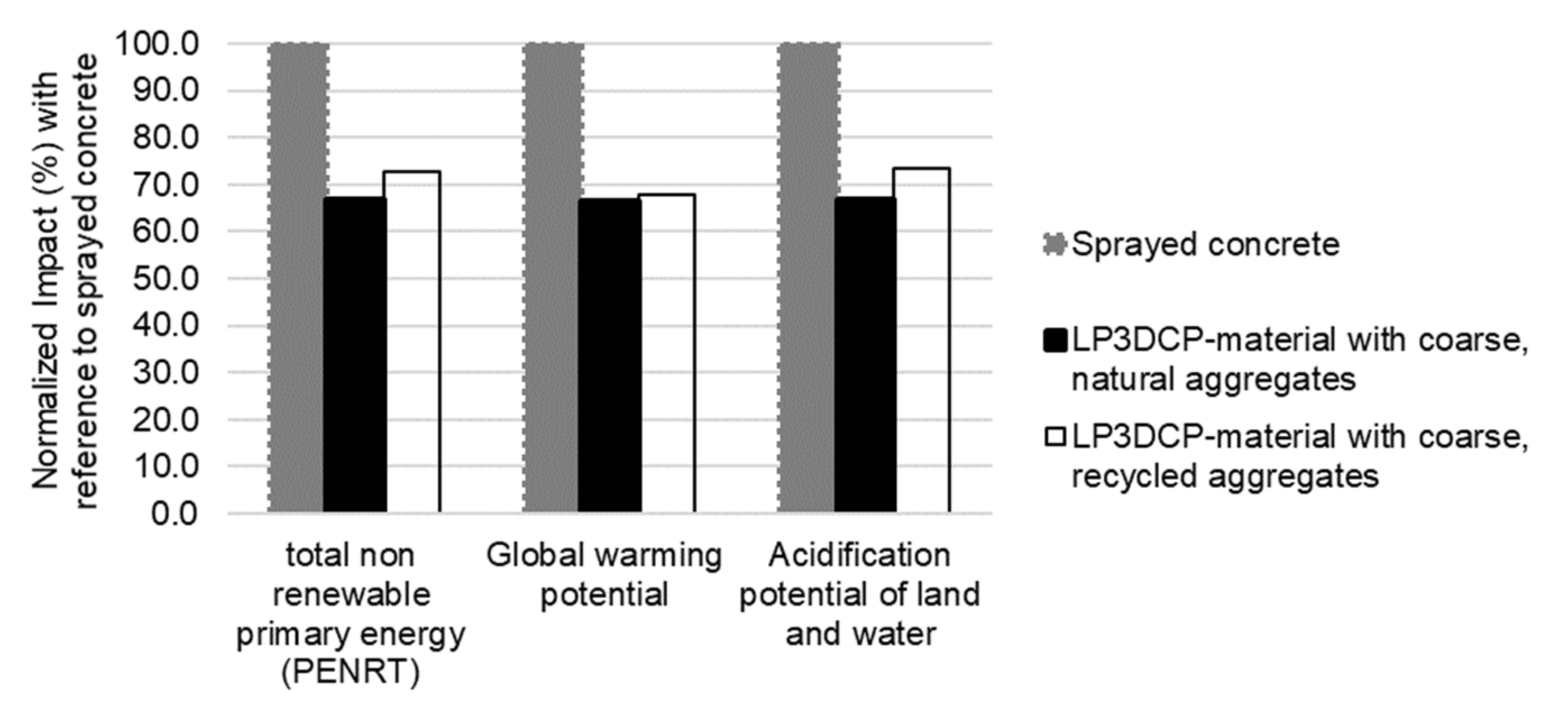
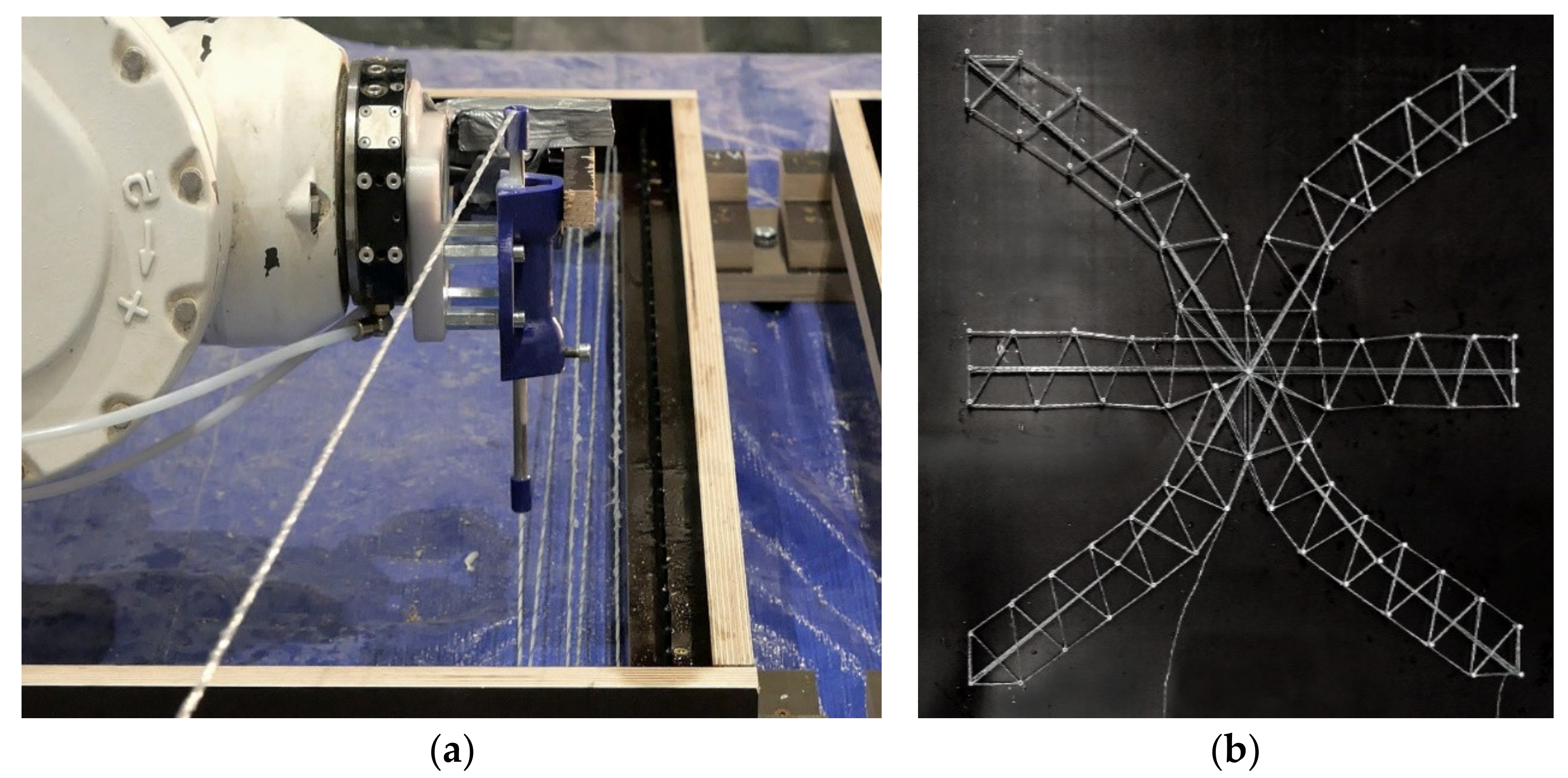

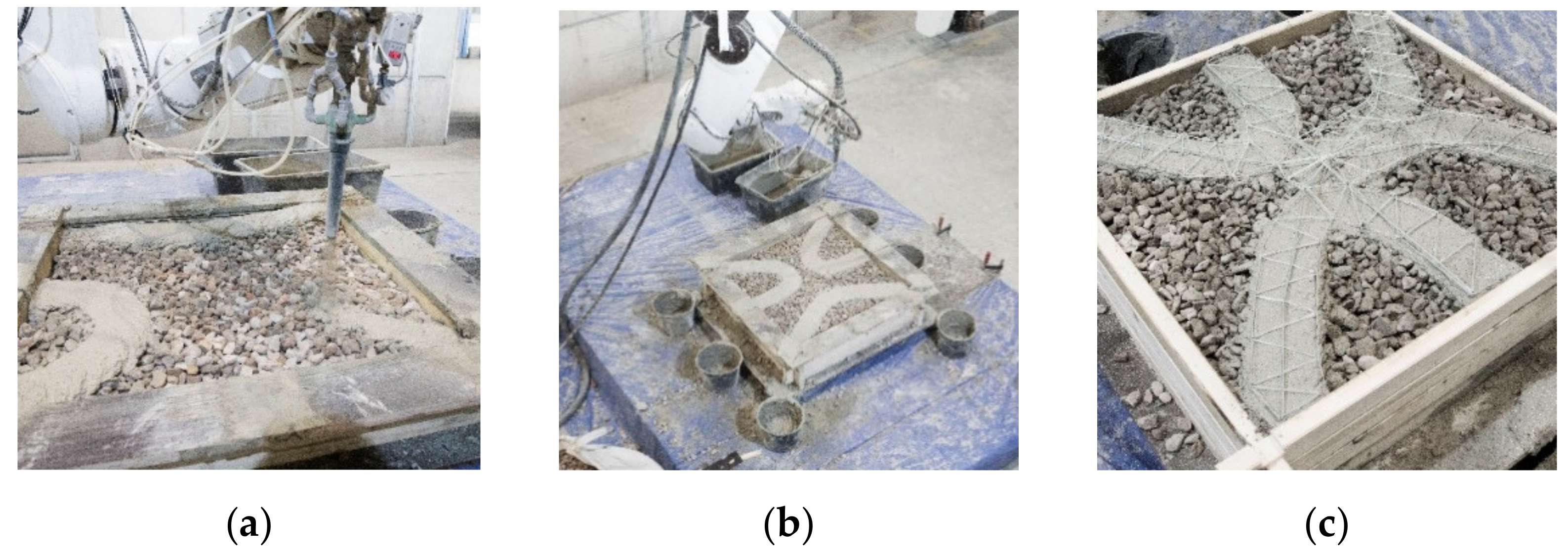
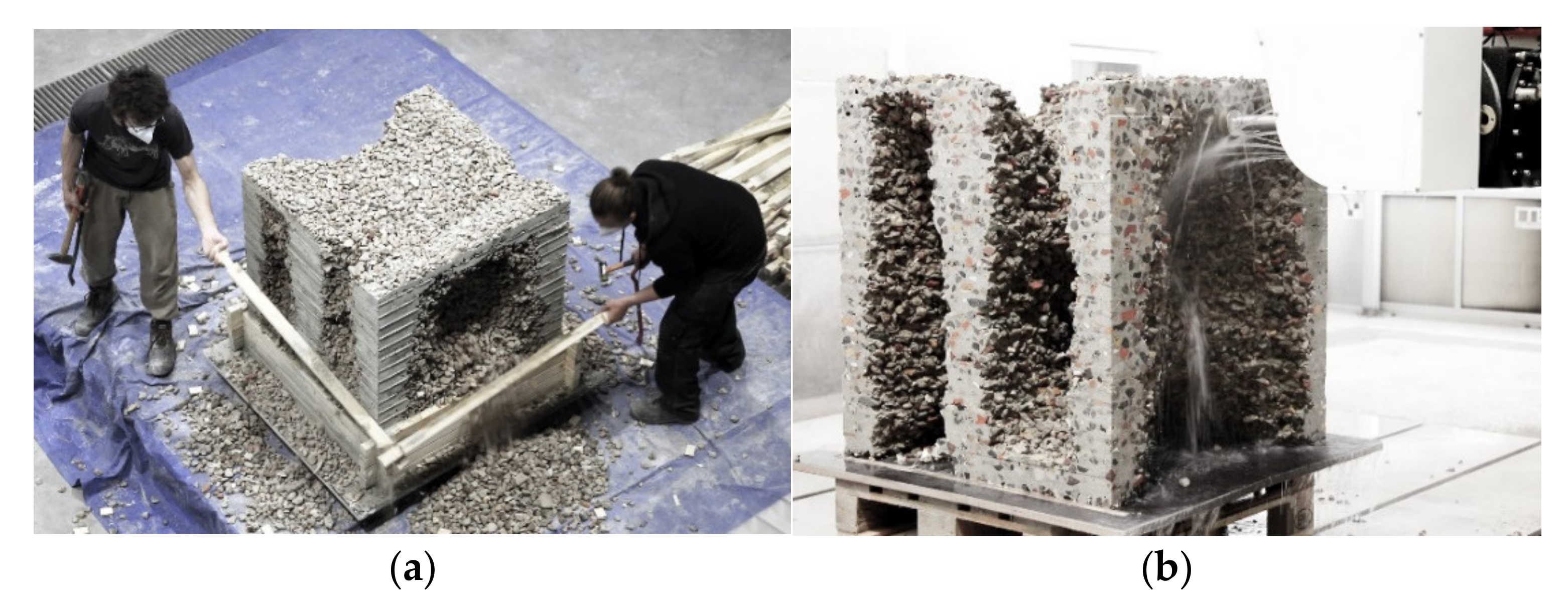
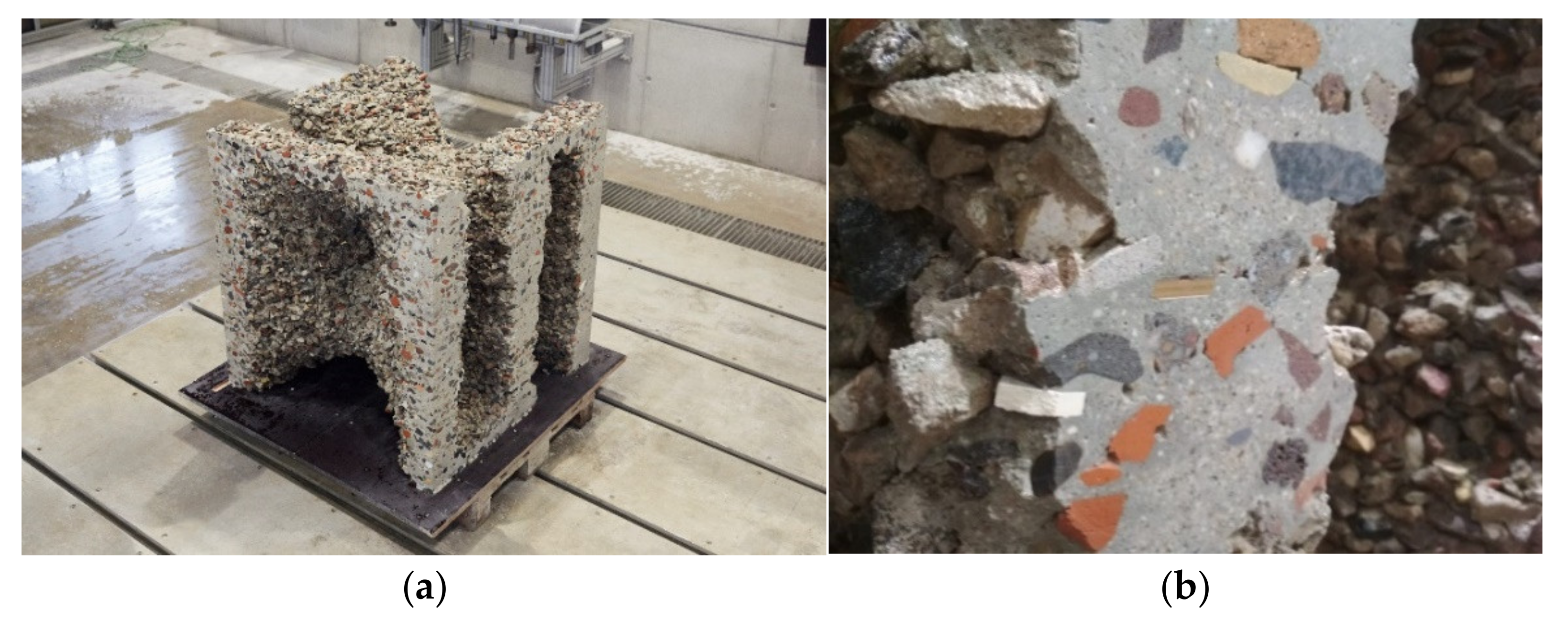
| Components | Particle Bed A | Particle Bed B |
|---|---|---|
| Particle Size (mm) | 16–32 | 4–32 |
| Bulk density (kg/m3) | 661.5 | 706.3 |
| Aggregate density (kg/m3) | 1620 | 1620 |
| Packing density (-) | 0.41 | 0.44 |
| Components | Value | Unit |
|---|---|---|
| Portland Cement (CEM I 52.5 R) | 600 | kg/m3 |
| Ground limestone | 97 | kg/m3 |
| Aggregate, d = 0–3.15 mm | 1258 | kg/m3 |
| Water | 270 | kg/m3 |
| Stabilizer | 0.0, 0.05 and 0.1 | % bwoc |
| PCE superplasticizer | 0.4 and 0.5 | % bwoc |
| Life Cycle Assessment Indicator Related to 1m3 3D-Printed Concrete | Sprayed Concrete | LP3DCP with Naturally Coarse Aggregates | LP3DCP with Recycled Coarse Aggregates |
|---|---|---|---|
| Total non-renewable primary energy (MJ/m3) | 2658.0 | 1765.6 | 1936.2 |
| Global warming potential (kg CO2-Eq./m3) | 680.5 | 452.0 | 461.4 |
| Acidification potential of land and water (kg SO2-Eq./m3) | 0.5 | 0.4 | 0.4 |
Publisher’s Note: MDPI stays neutral with regard to jurisdictional claims in published maps and institutional affiliations. |
© 2021 by the authors. Licensee MDPI, Basel, Switzerland. This article is an open access article distributed under the terms and conditions of the Creative Commons Attribution (CC BY) license (https://creativecommons.org/licenses/by/4.0/).
Share and Cite
Mai, I.; Brohmann, L.; Freund, N.; Gantner, S.; Kloft, H.; Lowke, D.; Hack, N. Large Particle 3D Concrete Printing—A Green and Viable Solution. Materials 2021, 14, 6125. https://doi.org/10.3390/ma14206125
Mai I, Brohmann L, Freund N, Gantner S, Kloft H, Lowke D, Hack N. Large Particle 3D Concrete Printing—A Green and Viable Solution. Materials. 2021; 14(20):6125. https://doi.org/10.3390/ma14206125
Chicago/Turabian StyleMai, Inka, Leon Brohmann, Niklas Freund, Stefan Gantner, Harald Kloft, Dirk Lowke, and Norman Hack. 2021. "Large Particle 3D Concrete Printing—A Green and Viable Solution" Materials 14, no. 20: 6125. https://doi.org/10.3390/ma14206125
APA StyleMai, I., Brohmann, L., Freund, N., Gantner, S., Kloft, H., Lowke, D., & Hack, N. (2021). Large Particle 3D Concrete Printing—A Green and Viable Solution. Materials, 14(20), 6125. https://doi.org/10.3390/ma14206125









